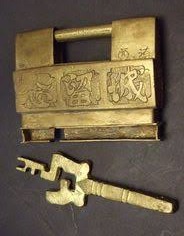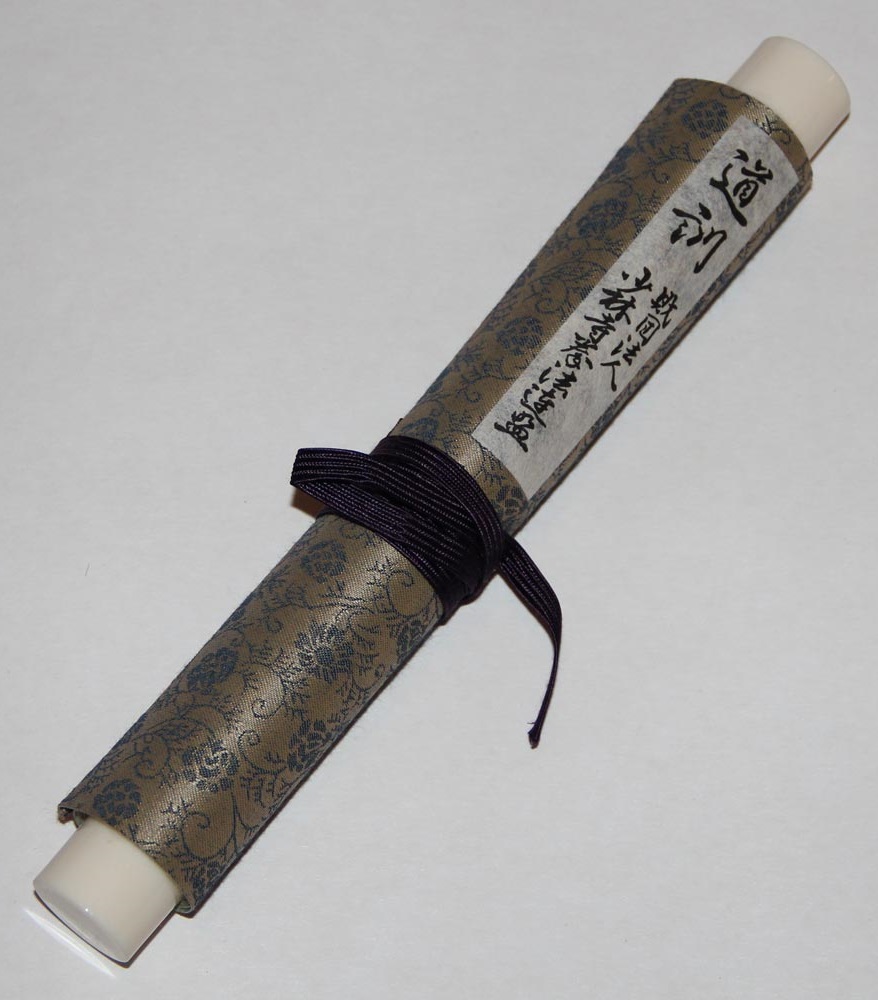Rohai Description
After bowing and announcing the name of the kata ("Rohai") ...
Yōi (cross open hands at groin level in
musubi dachi) and kiyomeri kokyū
(purification breaths)
Kamaete (shift right foot into nami heikō dachi
while spreading open hands to knee width,
thumb-sides up)
| 1 | Bend slightly forward from the waist whilst raising both hands morote shutō uke | |
| 2 | Step with the right foot into shiko dachi with migi yoko shutō barai | |
| 3 | Pivoting on the right foot, turn 90 degrees left into hidari neko-ashi dachi with hidari kakete uke (normal hikite) | |
| 4 | Yori-ashi forward in hidari neko-ashi dachi with gyaku-zuki | |
| 5 | Turning 90 degrees right into heisoku dachi perform morote hikite | |
| 6 | Step forward with the left foot, then sharply 45 degrees to the right into migi kōsa dachi and immediately leap backward into hidari sai-ashi dachi with simultaneous migi-te gedan shutō barai and hidari-te age shutō uke | |
| 7 | Step forward into migi han-zenkutsu dachi with hiji-sasae ura-shutō uke(1), then hiji-sasae kakete uke(1) | |
| 8 | Use right hand hikite to initiate stepping forward into hidari han-zenkutsu dachi with oizuki and gyaku-zuki | |
| 9 | Leap directly back onto left foot and pivot 90 degrees left into hidari sai-ashi dachi with simultaneous migi-te gedan shutō barai and hidari-te age shutō uke | |
| 10 | Step forward into migi han-zenkutsu dachi with hiji-sasae ura-shutō uke(1), then hiji-sasae kakete uke(1) | |
| 11 | Use right hand hikite to initiate stepping forward into hidari han-zenkutsu dachi with oizuki and gyaku-zuki, followed by simultaneous migi-ashi nami-gaeshi geri and hidari-te gedan shotei barai wide to the left side, then stepping to the right into shiko dachi with simultaneous hidari-te sukashi uke and migi-te gedan zuki and kiai | |
| 12 | Leap directly back onto left foot and pivot 90 degrees left into hidari sai-ashi dachi with simultaneous migi-te gedan shutō barai and hidari-te age shutō uke | |
| 13 | Step forward into migi han-zenkutsu dachi with hiji-sasae ura-shutō uke(1), then hiji-sasae kakete uke(1) | |
| 14 | Use right hand hikite to initiate stepping forward into hidari han-zenkutsu dachi with oizuki and gyaku-zuki | |
| 15 | Morote hikite whilst stepping forward into migi han-zenkutsu dachi then morote gedan hira-basami uchi(2) | |
| 16 | Draw right foot back into heisoku dachi and pull both hands to right hip in kansetsu waza (kote gaeshi) position | |
| 17 | Step forward into hidari han-zenkutsu dachi with migi-te ue morote zuki | |
| 18 | Draw lleft foot back into heisoku dachi and pull both hands to left hip in kansetsu waza (kote gaeshi) position | |
| 19 | Step forward into migi han-zenkutsu dachi with hidari-te ue morote zuki | |
| 20 | Draw right foot back into heisoku dachi and pull both hands to right hip in kansetsu waza (kote gaeshi) position | |
| 21 | Step forward into hidari han-zenkutsu dachi with migi-te ue morote zuki | |
| 22 | Draw left foot back into hidari neko-ashi dachi with shutō uke (normal hikite) | |
| 23 | Extend left hand into nukite position, then migi-ashi mikazuki geri against left palm and kiai, allowing the right foot to continue its arc and spin the body 180 degrees, then pivot another 180 degrees on the right foot into migi neko-ashi dachi with shutō uke (open-hand hikite at solar plexus) | |
| 24 | Step back with right foot into hidari neko-ashi dachi with shutō uke (open-hand hikite at solar plexus) | |
[Zanshin yame is not performed in Rohai]
Naotte (perform tekagami movement while
drawing
left
foot back into musubi dachi)
Rei (bow)


 When
learning a new kata, it is important to remind
oneself of the adage: "Manabu no tame ni hyakkkai,
jukuren no tame ni senkai, satori no tame ni manga
okonau" (学ぶのために百回、熟練のために千回、悟りのために万回行う.).
A hundred times to learn, a thousand
times for proficiency, ten thousand
repetitions for complete understanding.
A related Okinawan saying is "ichi kata san nen"
(一型三年): one kata three years. Think
of it this way: it takes about 40 seconds to
perform Heian Nidan. So in just ten
minutes per day for only ten days (or twenty minutes a
day for just five days), you can learn the correct
sequences of movements in Heian Nidan.
But to become truly proficient-to be able to perform it
correctly, and with the speed, power, timing, and bushi damashii (samurai spirit) necessary
to make its techniques effective in a real self-defence
situation will take a thousand repetitions, which
equates to 100 days at ten repetitions a day.
And to fully understand and apply all of its principles,
nuances, and variations will take 1,000 days (three
years) at ten repetitions per day.
When
learning a new kata, it is important to remind
oneself of the adage: "Manabu no tame ni hyakkkai,
jukuren no tame ni senkai, satori no tame ni manga
okonau" (学ぶのために百回、熟練のために千回、悟りのために万回行う.).
A hundred times to learn, a thousand
times for proficiency, ten thousand
repetitions for complete understanding.
A related Okinawan saying is "ichi kata san nen"
(一型三年): one kata three years. Think
of it this way: it takes about 40 seconds to
perform Heian Nidan. So in just ten
minutes per day for only ten days (or twenty minutes a
day for just five days), you can learn the correct
sequences of movements in Heian Nidan.
But to become truly proficient-to be able to perform it
correctly, and with the speed, power, timing, and bushi damashii (samurai spirit) necessary
to make its techniques effective in a real self-defence
situation will take a thousand repetitions, which
equates to 100 days at ten repetitions a day.
And to fully understand and apply all of its principles,
nuances, and variations will take 1,000 days (three
years) at ten repetitions per day.